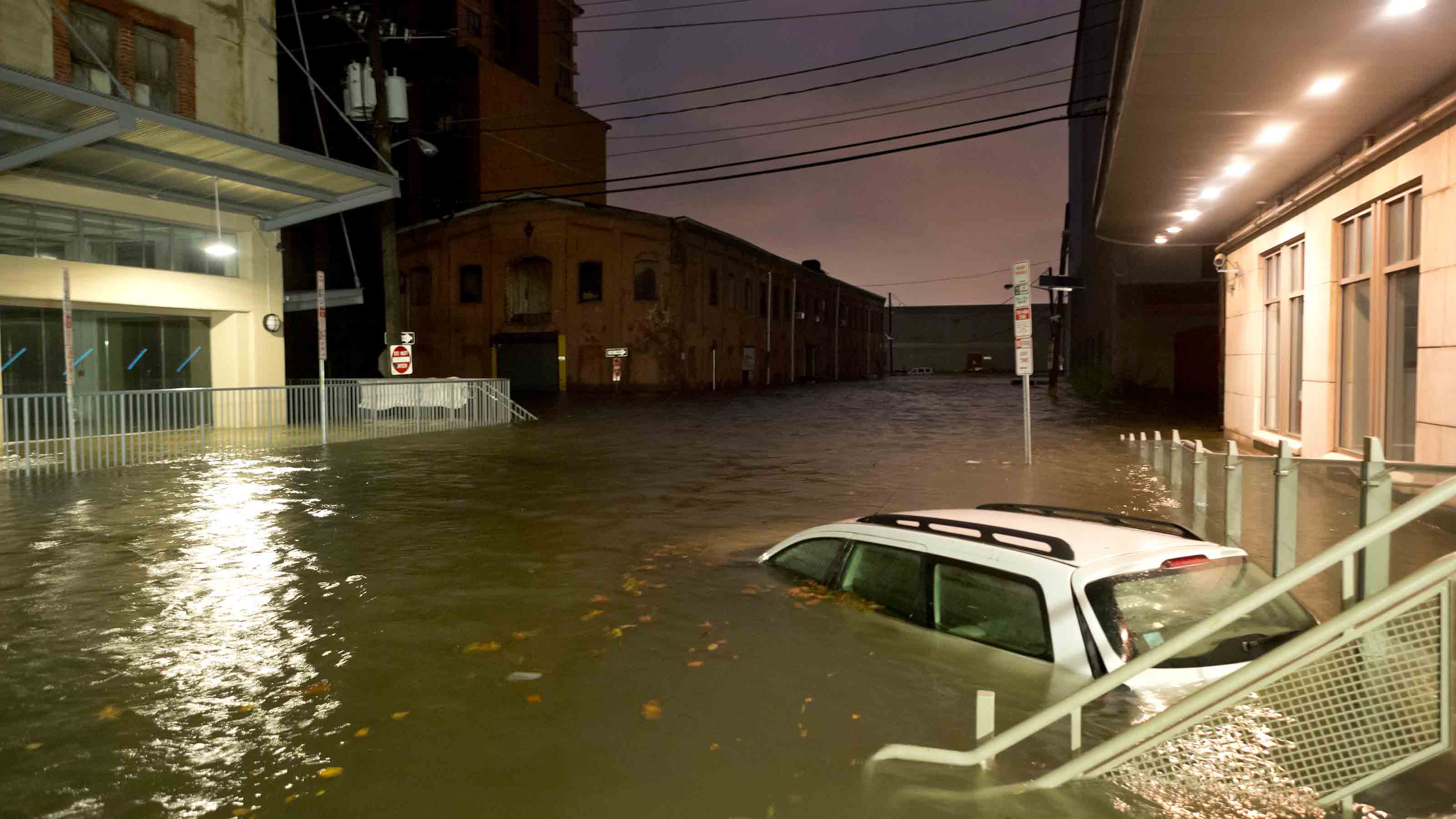Watch Out for Flood-Damaged Cars from Hurricane Ian
Even if Hurricane Ian passed you by unharmed, pay attention if you’re in the market for a vehicle. And be prepared to pay even more.


Among the destruction caused by Hurricane Ian, both across Florida and in areas of the East Coast that suffered its wrath: flooded vehicles. While this is a common outcome of cyclonic storms and their heavy rain and storm surge, Hurricane Ian struck in the middle of an already stressed car market.
You’ve probably heard about how an ongoing semiconductor shortage has led to a shortage of new cars; that in turn has raised demand (and prices on) used cars.
Just how many vehicles Hurricane Ian damaged will be assessed in the weeks to come, but if past is prologue, take a look at what Category 4 Atlantic Hurricane Ida did in 2021: It caused water damage to 212,000 cars, according to an estimate from CarFax.
Consumers having to replace hundreds of thousands of cars is about the last thing this market needed. But also: what happens to the flooded vehicles? Because water, whether salt or fresh, is so damaging to vehicles, many are written off as total losses, which means their owner (assuming they have comprehensive coverage on the vehicle) gets a check and is on their own to find a new car. But a portion of those flood damaged vehicles will be repaired and put back into service. That’s where car shoppers need to pay attention.
“CarFax estimates there are currently about 400,000 vehicles on the road with prior flood damage,” said Emilie Voss, public relations director for CarFax. “That’s up 6% from 2021 and those numbers are before Ian.”
Experts warn consumers shopping for used cars to be wary of the possibility of storm-damaged vehicles making their way into this tight market in 2023.
From just $107.88 $24.99 for Kiplinger Personal Finance
Become a smarter, better informed investor. Subscribe from just $107.88 $24.99, plus get up to 4 Special Issues

Sign up for Kiplinger’s Free Newsletters
Profit and prosper with the best of expert advice on investing, taxes, retirement, personal finance and more - straight to your e-mail.
Profit and prosper with the best of expert advice - straight to your e-mail.
Hiding Flood Damage Is Against the Law
When cars are flooded, bodies can rust prematurely, wiring can become brittle, and both electrical and mechanical systems can be affected – pricey computer modules mounted under the seats are a frequent victim.
Cars that are declared to be total losses are usually retitled with their state’s department of motor vehicles, and the new titles will disclose that the vehicles have been flood-damaged. In many cases, those cars will be sold to companies that dismantle them and resell usable parts. But sometimes people try to sell these cars without revealing the flood damage, which could create big risks for the buyers.
CarFax and the National Insurance Crime Bureau warn potential buyers to expect people with storm-damaged cars who don’t have comprehensive coverage insurance that covers flooding to try to clean up damaged cars and sell them to unsuspecting buyers.
“Many times, con men move these vehicles damaged in hurricanes from states like Florida and Texas, to states where flood damaged vehicles may not be top of mind, like Ohio and Connecticut,” said CarFax’s Voss. “Texas and Florida have the most flood cars on the road but we saw the biggest increases in New York and New Jersey last year, likely tied to Ida.
How to Avoid Buying a Flood-Damaged Car
If you’re buying a used car—especially one a few months after a major flooding event—be sure to take a close look. Your own eyes (and nose!) can help. Signs experts say you should look for include water stains, mildew and sand or salt inside vehicles, under the carpets and in luggage and engine compartments. You may need to open access panels to see areas where water would have accumulated. Of course, a mechanic’s inspection is always a good idea when buying a car, and if you suspect unreported flood damage, ask them to look for that as well as part of their process.
But documentation is important, too. Experts also advise using a service, such as CarFax, AutoCheck’s free VIN (or license plate) search tool and the National Insurance Crime Bureau’s free VINCheck to check vehicles’ histories for red flags. CarFax’s free Flood Check reports whether a car has a flood or salvage title from the state DMV, was declared a total loss by the insurance company, or was reported as flooded by repair shops. And Experian’s AutoCheck’s free flood risk check will show if the vehicle has been titled/registered 12 months prior in a county that has been identified as requiring public and individual assistance (FEMA categories A and B) for a FEMA-declared major disaster.
These services aren’t foolproof. Flooded vehicles won’t show up in the databases if they weren’t fully insured, or if repairs were done without a claim being filed. Also, sometimes crooks take the autos to different states, switch the VINs and retitle the cars, so the damage won’t show up in a search, in a process called title washing.
Most of the time it’s against the law to pass off a flood-damaged vehicle to an unsuspecting buyer. “Regulations vary by state, but in general vehicles ’totaled out’ by insurers because they have received a certain amount of damage are issued a salvage vehicle certificate, or salvage title,” said Tully Lehman, public affairs manager for the National Insurance Crime Bureau. “Some states take an additional step and add a title brand to the title for the reason why it was damaged. In other words, if damaged in flooding that would be marked as such in some states.”
But private sales aren’t as regulated, according to Lehman. “A private seller is not supposed to lie. If purchasing a vehicle from a private seller, get everything in writing as you may have some recourse should anything turn out to be false,” said Lehman.
When purchasing a used car, you should always check the VIN to be sure it matches what you’re being told by the seller.
For example, a VIN can provide vehicle history, but also make, model, year, color and engine. So alarm bells should sound if you’re told the car you’re buying is a blue 2006 Honda Accord, but when you look up the VIN it says it’s a 2004 or that its color is black.
“It could be an honest mistake by the seller, or perhaps not,” Lehman said. “In this case, best to walk away.”
Profit and prosper with the best of Kiplinger's advice on investing, taxes, retirement, personal finance and much more. Delivered daily. Enter your email in the box and click Sign Me Up.

Bob was Senior Editor at Kiplinger.com for seven years and is now a contributor to the website. He has more than 40 years of experience in online, print and visual journalism. Bob has worked as an award-winning writer and editor in the Washington, D.C., market as well as at news organizations in New York, Michigan and California. Bob joined Kiplinger in 2016, bringing a wealth of expertise covering retail, entertainment, and money-saving trends and topics. He was one of the first journalists at a daily news organization to aggressively cover retail as a specialty and has been lauded in the retail industry for his expertise. Bob has also been an adjunct and associate professor of print, online and visual journalism at Syracuse University and Ithaca College. He has a master’s degree from Syracuse University’s S.I. Newhouse School of Public Communications and a bachelor’s degree in communications and theater from Hope College.
-
 Stocks Struggle for Gains to Start 2026: Stock Market Today
Stocks Struggle for Gains to Start 2026: Stock Market TodayIt's not quite the end of the world as we know it, but Warren Buffett is no longer the CEO of Berkshire Hathaway.
-
 Tip: Ways to Track Your Credit Card Rewards
Tip: Ways to Track Your Credit Card RewardsHere are the best strategies and apps to help you stay current with your credit card rewards.
-
 How New Investors Can Pick Their Perfect Portfolio, According to a Pro
How New Investors Can Pick Their Perfect Portfolio, According to a ProSee what Cullen Roche has to say about finding your perfect portfolio as a new investor and his two-word answer on where he thinks the stock market is headed in 2026.
-
 9 Types of Insurance You Probably Don't Need
9 Types of Insurance You Probably Don't NeedFinancial Planning If you're paying for these types of insurance, you may be wasting your money. Here's what you need to know.
-
 10 Things You Should Know About Buying a Car Today, Even if You've Bought Before
10 Things You Should Know About Buying a Car Today, Even if You've Bought BeforeIf buying a car is on your to-do list, and it's been a while since you went shopping for a new one, this guide will help avoid any nasty shocks in the showroom.
-
 Get the Best Car Deal in Retirement: Here's the Trick
Get the Best Car Deal in Retirement: Here's the TrickPlanning on shopping for a new car this Labor Day weekend? Here’s how to haggle for a better price, even though you're retired.
-
 Seven Things You Should Do Now if You Think Your Identity Was Stolen
Seven Things You Should Do Now if You Think Your Identity Was StolenIf you suspect your identity was stolen, there are several steps you can take to protect yourself, but make sure you take action fast.
-
 The 8 Financial Documents You Should Always Shred
The 8 Financial Documents You Should Always ShredIdentity Theft The financial documents piling up at home put you at risk of fraud. Learn the eight types of financial documents you should always shred to protect yourself.
-
 How to Guard Against the New Generation of Fraud and Identity Theft
How to Guard Against the New Generation of Fraud and Identity TheftIdentity Theft Fraud and identity theft are getting more sophisticated and harder to spot. Stay ahead of the scammers with our advice.
-
 12 Ways to Protect Yourself From Fraud and Scams
12 Ways to Protect Yourself From Fraud and ScamsIdentity Theft Think you can spot the telltale signs of frauds and scams? Follow these 12 tips to stay safe from evolving threats and prevent others from falling victim.
-
 Watch Out for These Travel Scams This Summer
Watch Out for These Travel Scams This SummerIdentity Theft These travel scams are easy to fall for and could wreck your summer. Take a moment to read up on the warning signs and simple ways to protect yourself.